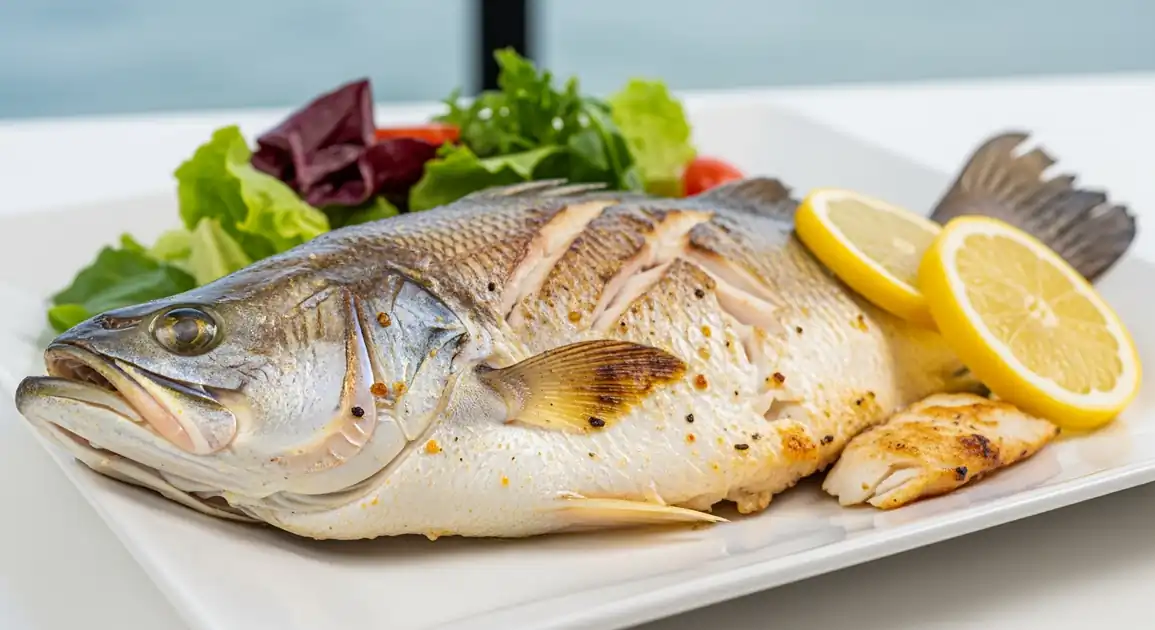Barramundi
Barramundi

Description
Barramundi is a highly popular fish across Australia, available in restaurants, pubs, fish & chip shops, and seafood markets nationwide. Both farmed and wild options are common, with farmed ensuring year-round availability.
Dietary Information
Serving information
Serving style
Highly varied: grilled with lemon/salad/chips, pan-fried with sauces/veg, battered with chips, steamed whole, baked in parcels. Served hot.
Quick facts
Restaurants: Lunch (12 PM - 3 PM), Dinner (6 PM - 10 PM). Fish & Chip Shops: often 11 AM - 8 PM. Markets: Early morning until mid/late afternoon.
Safety Tips
What to Look For
-
Fish cooked thoroughly
Flesh should be opaque all the way through and flake easily. This minimizes risk from potential parasites or bacteria.
-
Fresh smell (clean ocean/water scent)
Applies to raw fish at markets/counters. Avoid any strong 'fishy' or ammonia-like odours.
-
Firm, springy flesh
When buying raw fillets or whole fish, the flesh should bounce back when pressed gently.
-
Clear, bright eyes and red gills (whole fish)
Key indicators of freshness for whole fish. Avoid cloudy/sunken eyes or brown/grey gills.
-
Reputable source (busy market, trusted restaurant)
Vendors with high turnover and good reputations are more likely to handle seafood properly.
What to avoid
-
Undercooked or raw Barramundi
Increases the risk of foodborne illness. Always ensure it's cooked through unless specifically prepared as sashimi/ceviche by a trusted professional source (rare for Barra).
-
Strong 'fishy' or ammonia smell
A clear sign the fish is old or deteriorating.
-
Soft, mushy, or gaping flesh
Indicates the fish is not fresh.
-
Cross-contamination
Ensure raw fish is handled separately from cooked food and ready-to-eat items like salads.
-
Fish displayed poorly (e.g., not on ice)
Fresh fish should be kept properly chilled to maintain quality and safety.
Price information
Price range
Budget tips
- Fish & chip shop Barramundi is usually the most budget-friendly cooked option (around 10-15 AUD per piece).
- Buying fresh fillets from a market (approx 30-60 AUD/kg) and cooking yourself is cheaper than restaurant dining.
- Restaurant prices for a main course range widely (25-50+ AUD depending on venue).
- Farmed Barramundi is generally less expensive than wild-caught.
Value indicators
- Freshness indicators (smell, appearance).
- Properly cooked (moist, flaky, not dry).
- Crispy skin (if pan-fried/grilled).
- Good portion size for the price.
Where to Find This Dish
Coastal Towns & Cities
Abundant availability in restaurants and markets near the coast.
Beachfront cafes, Harbourside restaurants
Lunch, Dinner
Major City Fish Markets
Offer fresh catches, including Barramundi (e.g., Sydney, Melbourne, Brisbane fish markets).
Central fish markets
Morning (for freshest selection)
Suburban Fish & Chip Shops
Ubiquitous local shops offering battered/crumbed options.
Local shopping strips
Lunch, Dinner (especially Friday/Weekends)
Vendor Tips
- Ask if the fish is farmed or wild if you have a preference.
- Specify how you want it cooked if options are available (grilled, fried, etc.).
- Check daily specials boards in pubs and restaurants for fresh Barramundi dishes.
How to Order
Regional Variations
-
Grilled Barramundi
(Grilled Barramundi)
Fillet cooked on a grill or flat-top, often served skin-on and crispy. Typically served with lemon, chips, or salad.
-
Pan-Fried Barramundi
(Pan-Fried Barramundi)
Fillet cooked in a pan, often with butter or oil, resulting in crispy skin and moist flesh.
-
Battered Barramundi
(Battered Barramundi)
Fillet coated in batter and deep-fried. A classic component of Australian fish and chips.
-
Crumbed Barramundi
(Crumbed Barramundi)
Fillet coated in breadcrumbs and fried or baked.
-
Steamed Barramundi
(Steamed Barramundi)
Whole fish or fillet steamed, often with Asian-inspired flavours like ginger, soy sauce, and spring onions.
-
Baked Barramundi
(Baked Barramundi)
Fillet or whole fish baked in the oven, sometimes with vegetables, herbs, or sauces.
Cultural context
History
Native to Northern Australia and the Indo-West Pacific, Barramundi has long been a food source for Indigenous Australians. It gained mainstream popularity across Australia in the late 20th century. The development of aquaculture (fish farming) from the 1980s onwards made Barramundi consistently available year-round and cemented its status as a national favourite.
Local significance
Considered an iconic Australian fish, representing both native wildlife and modern aquaculture. A symbol of Australian dining, from casual fish & chips to upscale cuisine.
Eating customs
- Typically eaten with knife and fork.
- Lemon wedge accompaniment is almost standard.
- Paired well with crisp white wines (e.g., Sauvignon Blanc, Riesling).